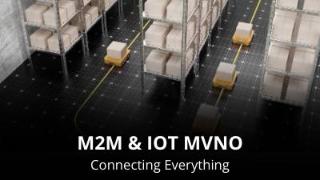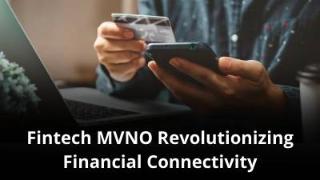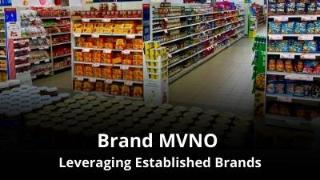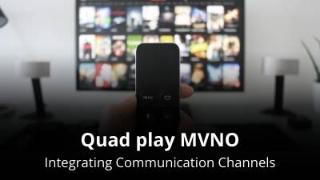Introduction about starting a Fintech MVNO (Mobile Brand)
The Fintech MVNO/IOT is poised for significant growth. In today’s rapidly evolving financial landscape, consumers demand seamless, secure, and personalized financial services accessible anytime, anywhere. This includes traditional financial services as well as the rapidly growing world of digital assets and cryptocurrencies. Fintech Mobile Virtual Network Operators (MVNOs) are stepping up to meet this demand, offering specialized mobile services designed specifically for financial transactions, management, and access to the crypto economy. These innovative operators are redefining how people interact with their finances, creating a connected ecosystem of financial tools, services, and digital assets. Financial institutions, neobanks, fintech companies, and crypto exchanges are constantly seeking ways to enhance customer engagement, offer innovative products, and expand their reach. By providing branded mobile services, these organizations can offer customers a powerful tool for managing their finances, including cryptocurrencies, directly from their mobile devices, fostering stronger customer relationships and driving business growth.What do you need to know about starting a Fintech MVNO/IOT
- What are the advantages and disadvantages ?
- What are the Revenue sources and Pricing strategy?
- What are suitable segments?
- What kind of Mobile bundles are typically used?
- What kind of ARPU can you expect?
- What is the Go-to-Market Strategy?
- What are some points to think of for the Marketing Plan?
- What kind of financing is to be expected?
- What kind of MVNO type is typically used?
- What is the expected time for the launch?
- What is the expected impact of 5G?
- What is the expected impact of eSIM?
- IOT and its Relation to Fintech MVNOs
- Benefits of Launching FinTech MVNO/IOT
- Frequently Asked Questions
- Summary
What are the advantages and disadvantages of a Fintech MVNO/IOT?
Advantages: Fintech MVNOs provide customers with secure mobile banking, real-time transaction alerts, budgeting tools, and access to financial advice, enhancing financial management and inclusion. They also offer a strong branding opportunity for financial institutions.
Disadvantages: Stringent regulatory requirements and security concerns related to financial data necessitate robust security measures and compliance. Maintaining customer trust and ensuring data privacy are crucial challenges.
What are the Revenue sources and Pricing strategy?
Revenue Sources: Fintech MVNOs generate revenue through subscription fees for premium features, transaction fees (in some cases), partnerships with financial service providers (e.g., insurance, investment platforms), and data analytics services (with appropriate privacy safeguards).
Pricing Strategy: Tiered pricing models can be adopted, offering basic plans for essential financial services and premium packages with advanced features like personalized financial advice, investment tools, and international money transfer capabilities at higher price points.
What are suitable segments for Fintech MVNO/IOT?
- Unbanked/Underbanked Populations: Providing access to basic financial services via mobile phones, fostering financial inclusion. Extending financial services to areas with limited access to traditional banking infrastructure.
- Millennials and Gen Z: Offering mobile-first banking and investment solutions, catering to their digital-native preferences.
- Small Business Owners: Providing tools for managing finances, invoicing, accepting payments, and accessing small business loans.
- International Travelers/Expats: Offering convenient and cost-effective international money transfer services, currency exchange, and multi-currency accounts.
- Gig Economy Workers: Providing tools for managing income, expenses, taxes, and accessing flexible financial products.
- Low-Income Households: Offering budgeting tools, micro-loans, and access to government benefits through mobile platforms.
- Students: Providing student loans, budgeting apps, and financial literacy resources.
- Crypto Investors/Traders: Providing secure access to crypto exchanges, wallets, and portfolio management tools, with real-time price alerts and market analysis.
- Investors/Traders: Offering access to stock markets, cryptocurrency trading platforms, and portfolio management tools.
- Older people: Providing simplified mobile banking interfaces, fraud protection services, and assistance with managing retirement funds.

What kind of Mobile bundles are typically used for a Fintech MVNO/IOT?
Data: Sufficient data for accessing banking apps, conducting transactions, and receiving financial updates. Security is paramount.
Voice: Voice/Speech Authentication, Customer support and financial advisory services.
SMS: Transaction alerts, two-factor authentication, and promotional messages (with opt-in).
What kind of ARPU can you expect for a Fintech MVNO?
ARPU: Moderate to high.
Why: Depending on the target segment and the range of services offered. Customers using premium financial services, including crypto trading and management tools, are typically willing to pay more.
Where It Is Based On: ARPU will be based on the value proposition of the financial services offered, including security, convenience, and access to premium features and crypto services.
You need to work out the details in your Financial Plan.

What is the Go-to-Market Strategy for a Fintech MVNO?

A successful Go-to-Market strategy for a Fintech MVNO requires a multi-faceted approach that considers the unique challenges and opportunities within the financial and telecommunications sectors. Building trust and demonstrating value are paramount, especially when dealing with sensitive financial information.
- Target Audience: Begin with a precise definition of your target audience. Consider factors such as demographics, financial needs, tech savviness, and existing banking relationships.
- Pricing Strategy: Develop a competitive and transparent pricing model. For example: Tiered Plans: Offer different plans with varying levels of service and data allowances. Transaction Fees: Clearly disclose any transaction fees associated with financial services. Crypto Trading Fees: Offer competitive trading fees to attract crypto users.
- Distribution Channels: Online channels, partnerships with retailers, and collaborations with community organizations.
- Promotion: Craft compelling marketing messages that emphasize security, convenience, and access to financial tools.
- Customer Support: 24/7 sports-focused support, multilingual support teams, and personalized fan advice for subscribers.
What are points to think of for the Marketing Plan for a Fintech MVNO?
To effectively market your Fintech Mobile Virtual Network Operator (MVNO), concentrate on the core value propositions: security, convenience, and financial empowerment, including access to the crypto economy. Develop targeted campaigns that resonate with each specific customer segment (e.g., unbanked, small businesses, crypto enthusiasts, etc.). Emphasize the ease of use of your mobile platform for both traditional finance and crypto management. Build trust by highlighting security measures, regulatory compliance, and partnerships with reputable financial and crypto institutions. Offer educational resources on financial literacy and crypto investing and showcase success stories. These strategies will position your Fintech MVNO as a trusted and valuable financial partner, driving customer acquisition and retention. You need to work out below points in your Marketing Plan.
USP: Secure and convenient mobile access to financial services.
Content Creation: Educational content on financial literacy, security tips, and product demos.
Promotions: Incentives for signing up, referral programs, and partnerships with complementary services.
Partnerships: Collaborations with financial institutions, retailers, and community organizations.
Feedback Loop: Continuous monitoring of customer feedback and regulatory changes.

What kind of financing is to be expected for Fintech MVNOs?

Financing: Moderate to High
Financing for Fintech MVNOs varies from moderate to high, depending on the scope of the MVNO and the required technological infrastructure for secure financial transactions.
You need to work the details in your Financial Plan.
What kind of MVNO type is typically used for Fintech MVNOs?
MVNO Type: Light or Thick/Full MVNO
This allows to ensure maximum control over security and service customization. This allows Fintech MVNOs greater control over their network infrastructure and service offerings, particularly regarding security protocols and data encryption. This autonomy enables them to customize their services extensively, ensuring they meet the stringent security and compliance requirements of the financial industry. This is crucial for maintaining customer trust and safeguarding sensitive financial data
See also: Different types of MVNOs
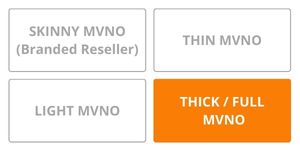
What is the expected time to launch for Fintech MVNOs?
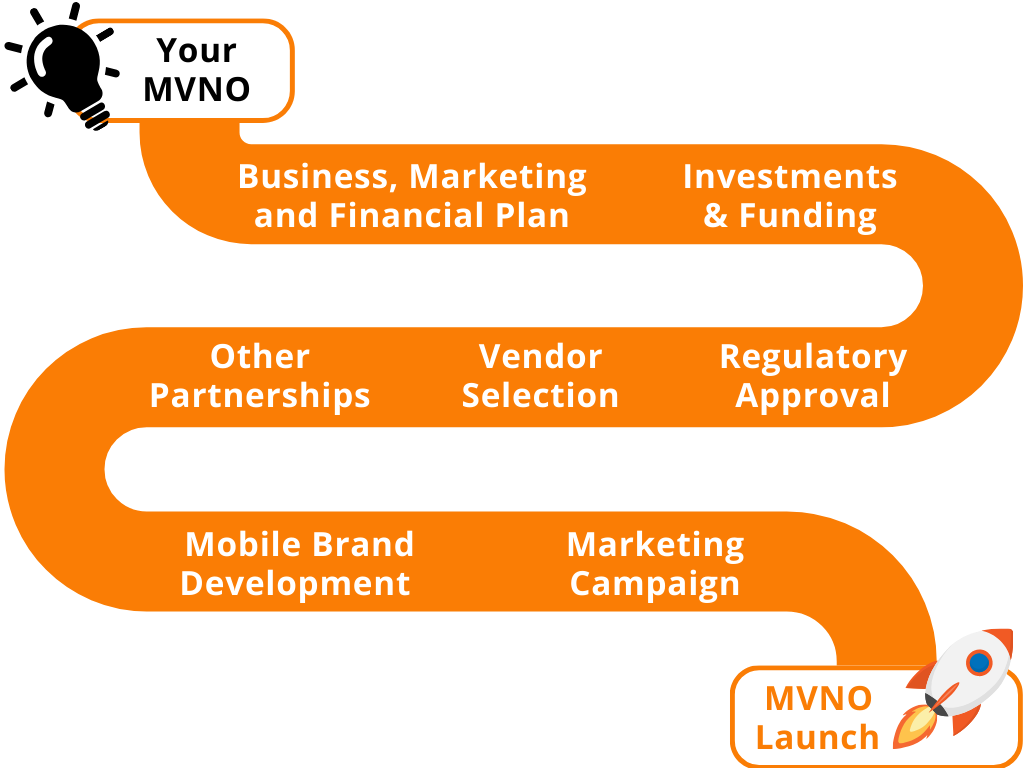
Expected Time to Launch: 12-18 months
Because of to the complexity of integrating with financial systems and meeting regulatory requirements. Building secure integrations with core banking systems, developing robust security protocols, and navigating complex regulatory landscapes necessitate careful planning and execution.
Utilizing agile development methodologies, focusing on a Minimum Viable Product (MVP) for initial launch, and leveraging pre-built fintech platforms can expedite the process. However, thorough security testing and compliance audits are crucial and should not be compromised for speed. By focusing on a phased rollout and prioritizing key features, Fintech MVNOs can launch efficiently while ensuring a secure and compliant platform.
What is the expected impact of 5G for Fintech MVNOs?
The rollout of 5G networks presents a significant opportunity for Fintech MVNOs, enabling faster, more secure, and more reliable financial and crypto transactions. 5G’s high bandwidth and low latency will facilitate real-time data processing, enhancing fraud detection capabilities and enabling seamless mobile banking and crypto trading experiences, including high-definition video banking, instant loan approvals, and rapid crypto trading execution.
Furthermore, 5G will support the development of innovative financial services such as augmented reality (AR) applications for investment visualization, including crypto portfolio tracking, and virtual reality (VR) experiences for financial and crypto education, creating more engaging and immersive customer interactions. The enhanced security features of 5G will also provide a more robust environment for protecting sensitive financial and crypto data. For more details see the Mobile Network section.

What is the expected impact of eSIM for Fintech MVNOs?

eSIM technology offers significant advantages for Fintech MVNOs by streamlining customer onboarding and enhancing flexibility. eSIMs eliminate the need for physical SIM cards, allowing for instant activation of financial service plans and seamless switching between different financial providers or service packages. This simplifies the customer experience and reduces friction in accessing financial services. For international travelers and expats, eSIMs enable easy access to local mobile networks and financial services without the need for physical SIM card changes. This is particularly beneficial for Fintech MVNOs targeting these segments. Moreover, eSIMs can enhance security by making it more difficult for fraudsters to intercept or clone SIM cards. For more details see the SIM section.
IOT and its Relation to Fintech MVNOs
Fintech MVNOs, bridging the gap between telecommunications and financial services, can leverage IoT to offer innovative financial solutions, enhance security, and improve customer experiences. While the original text focused on entertainment and fan engagement, Fintech MVNOs can utilize IoT for entirely different, finance-focused applications. Here’s how:
Wearable Payments and Biometric Authentication: Instead of tracking fan activity, wearable devices like smartwatches and fitness trackers can be used for contactless payments and biometric authentication. Fintech MVNOs can enable secure and convenient transactions through these devices, offering a seamless and modern payment experience. Biometric data, with appropriate consent and privacy safeguards, can enhance security and prevent fraud.
Connected Point-of-Sale (POS) Systems and Merchant Services: Instead of focusing on entertainment venues, IoT can be used to connect POS systems for small businesses and merchants. This allows for real-time transaction processing, inventory management, and data analytics. Fintech MVNOs can offer bundled packages that include connectivity, POS hardware, and financial services, providing a comprehensive solution for merchants.
Personalized Financial Advice and Management: By integrating with financial management apps and connected devices, Fintech MVNOs can offer personalized financial advice and management tools. For example, data from spending trackers and connected bank accounts can be used to provide personalized budgeting recommendations and financial planning tools.
Fraud Detection and Security: IoT sensors and connected devices can be used to enhance fraud detection and security for financial transactions. For example, location data from mobile devices can be used to verify the legitimacy of transactions and prevent fraudulent activity. Behavioral biometrics collected from wearable devices can also be used to enhance authentication and security.
Insurance and Risk Assessment: IoT devices can be used to collect data for insurance and risk assessment purposes. For example, connected car devices can be used to track driving behavior and offer usage-based insurance premiums. Wearable health trackers can be used to assess health risks and offer personalized insurance plans.
IoT-Enabled Financial Inclusion: IoT can play a crucial role in expanding financial inclusion by providing access to financial services for underserved populations. For example, connected mobile devices can be used to facilitate mobile banking, microloans, and insurance services in areas with limited access to traditional banking infrastructure.
Supply Chain Finance and Tracking: For businesses involved in supply chain management, IoT can provide real-time tracking of goods and payments. This can improve transparency, efficiency, and security in financial transactions throughout the supply chain.
By integrating IoT data and services into their offerings, Fintech MVNOs can offer innovative financial solutions, enhance security, and improve customer experiences, differentiating themselves from traditional financial institutions and mobile operators. They can become key players in the evolving landscape of digital finance.
Benefits of Launching FinTech MVNO/IOT
Improved Financial Inclusion and Access to Services: Provide affordable connectivity and mobile banking solutions to underserved populations, expanding access to financial services and promoting financial inclusion. Therefore, this empowers individuals and businesses with limited access to traditional banking infrastructure.
Personalized Financial Management and Advice: Leverage data from connected devices and financial apps to offer personalized financial advice, budgeting tools, and investment recommendations. Consequently, this helps customers better manage their finances, make informed financial decisions, and achieve their financial goals.
New Revenue Streams through Innovative Financial Products: Offer innovative financial products and services, such as mobile payments, microloans, and insurance, bundled with mobile connectivity. This, therefore, creates new revenue streams for Fintech MVNOs and provides customers with convenient and accessible financial solutions.
Enhanced Security and Fraud Prevention: Offer secure connectivity and biometric authentication solutions for financial transactions, reducing the risk of fraud and enhancing security for customers. This, in turn, builds trust and confidence in mobile financial services, encouraging wider adoption.
Connected Devices for Financial Data Collection: Utilize connected devices for financial data collection, such as smart meters for usage-based insurance or wearable sensors for health insurance.
Secure IoT Devices for Financial Transactions: Utilize secure IoT devices for financial transactions, such as biometric authentication devices or secure payment terminals.
Frequently Asked Questions
1. How will the Fintech MVNO ensure the security of financial transactions and customer data, including crypto assets?
Fintech MVNOs will employ multiple layers of security, including end-to-end encryption for all transactions (both fiat and crypto), multi-factor authentication (MFA), biometric authentication (fingerprint, facial recognition), fraud detection systems, and regular security audits. For crypto assets, secure cold storage solutions, multi-signature wallets, and compliance with relevant crypto regulations will be implemented. Compliance with industry standards like PCI DSS, relevant data privacy regulations (e.g., GDPR), and crypto-specific security standards will be strictly adhered to. Partnerships with reputable security providers and penetration testing will further enhance security measures.
2. What regulatory licenses and compliance measures are required for operating a Fintech MVNO offering crypto services?
The specific licenses and compliance requirements will vary significantly depending on the jurisdiction in which the Fintech MVNO operates and the specific financial and crypto services offered. In addition to licenses related to EMIs, PIs, or banking licenses, licenses related to virtual asset service providers (VASPs) or other crypto-related regulations may be required. Compliance with anti-money laundering (AML) regulations, know-your-customer (KYC) procedures, data protection laws, and other relevant financial and crypto regulations will be mandatory. This includes compliance with regulations related to crypto exchanges, custody services, and other crypto-related activities.
3. How will the Fintech MVNO integrate with existing financial systems and infrastructure?
Integration with existing financial systems will typically be achieved through secure APIs (Application Programming Interfaces) that allow the Fintech MVNO’s platform to communicate with core banking systems, payment gateways, and other financial service providers. Secure data exchange protocols and robust authentication mechanisms will be essential for ensuring the integrity and security of these integrations.
4. What customer support channels will be available to address financial inquiries and technical issues?
Fintech MVNOs will offer multiple customer support channels, including phone support, email support, live chat, and online self-service portals with FAQs and tutorials. Dedicated support teams trained in both financial services and technical troubleshooting will be available to assist customers. Multilingual support will be offered where relevant.
5. How will the Fintech MVNO handle fraud prevention and dispute resolution?
Fraud prevention will be addressed through real-time transaction monitoring, anomaly detection algorithms, and fraud scoring systems. In case of disputes, a clear dispute resolution process will be established, involving investigation of the disputed transaction, communication with the customer, and resolution in accordance with relevant regulations and internal policies. Collaboration with payment processors and financial institutions will be crucial for effective dispute resolution.
Summary
In summary, Fintech MVNOs have the potential to transform the financial services industry by providing secure, convenient, and accessible financial tools to a wider audience. However, addressing security concerns, navigating regulatory complexities, and building customer trust are critical factors for success.


